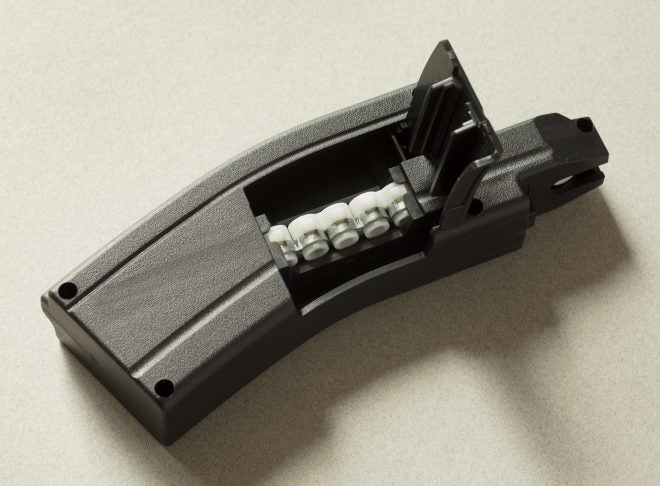Review: Sig MPX ASP Pellet Gun
Oleg Volk 05.16.17

The resurgence in popularity of pellet guns comes from several overlapping factors: the expense and decreased availability of rimfire ammunition, the expense and often the lack of proximity of gun ranges, and the accuracy limitations of BB guns, along with the increased ricochet risk posed by those hard spherical projectiles. Certain technical advances, chiefly magazines with internal belts capable of reliably feeding 30 pellets and 90 gram CO2 cartridges, make the new wave of pellet guns, like this Sig MPX, far more useful for marksmanship training than older or simpler models.

The magazine design is good, but it comes with a small pellet seating tool which can be easily lost. There’s no easy way to attach that tool to anything. Fortunately, a replacement can be easily improvised. Sig pellets proved to be quite accurate and seem to be better matched to the MPX than other brands I tried.
Being able to just walk out on the back porch and shoot at the target garden installed 15 yards away has been a great help for keeping marksmanship proficiency between real range trips. Backing up to 25 yards (the full diagonal of my back yard) makes the smallest 1.5″ targets a little more challenging. Mechanically, the air gun seems capable of about 1″ groups at 20 yards using the included red dot sight.
The MPX is not pressure-regulated, so velocity varies by around 5% between shots. At the distances I shot, that made little difference in practical accuracy. Each 90-gram CO2 cartridge was good for 80-100 shots, depending on the rate of fire, before velocity dropped off. At 570-600 fps, wadcutter pellets have enough energy to spin metal targets and they cut nice clean holes in paper.
The MPX airgun controls are only a partial representation of those on a real MPX, as the left side mag release and slide lick levers are merely decorative. The overall look and feel does resemble the 9mm original quite well. The report is quiet, on par with sound-suppressed 22 LR or better.
The two main limitations are the trigger and the CO2 power source. The trigger is DAO, so pulling it immediately after the reset leads to a blank shot. In other words, the trigger should be released after every shot in order to advance the belt to present the next pellet.
CO2 canisters cool off and lose efficiency if the gun is fired rapidly. The combination of these factors makes effective rapid fire impractical.
Both the cost and the rapid-fire limitations of CO2 powerlets can be addressed with a compressed air replacement tank made by Air Venturi, which greatly increases capacity and gives MPX rapid fire capability AND a regulated air supply (thereby increasing accuracy). Unfortunately, the replacement tank lengthens the stock, making it suitable only for adults.
Spherical steel BBs tend to ricochet from hard backstops, while pellets usually deform and bounce back much less. A soft curtain of plastic or cloth placed in front of the backstop usually arrests ricochets entirely and reduces the noise of pellet impacts. Proper eye protection should still be worn, but no ear protection is required.
Since the air MPX looks realistic, it helps with the introduction of new shooters to firearms, bridging the gap between CO2 and gunpowder projectile launchers. I found it extremely useful for pro-RKBA PR, allowing me to illustrate safe recreational shooting and to practice safe gun handling.
The short and handy size is also helpful for illustrating the impositions of the NFA 1934 that regulates barrel length and causes the actual carbines to be less handy than the pellet gun clones.
Manufacturer Specs
- Model: SIG MPX ASP
- Operating System: CO2
- Caliber: .177 cal
- Muzzle Velocity: up to 575 fps (may vary based on ammo weight, temperature, and altitude)
- Trigger Pull: 7 lb (31 N)
- Stock Type: Synthetic
- Accessory Rail: M1913
- Sights: Red Dot
- Mags Included: (1) 30rd Pellet Mag
- Overall Length: 25.75 in (654 mm)
- Weight: 6.6 lb (3 kg)
- MSRP: $245.99





